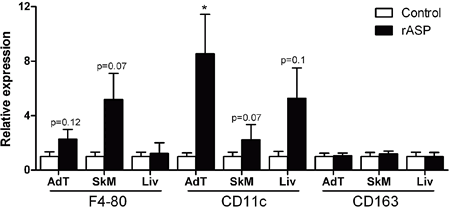ICEECE2012 Poster Presentations Obesity (114 abstracts)
ASP injection promotes macrophage infiltration and M1 polarization in obese adipose tissue
A. Fisette 1 , K. Oikonomopoulou 2 , M. Munkonda 1 , J. Lambris 2 & K. Cianflone 1
1Centre de Recherche de l’Institut Universitaire de Cardiologie et de Pneumologie de Québec, Quebec, Quebec, Canada; 2University of Pennsylvania, Philadelphia, Pennsylvania, USA.
Recent integrative approaches showed that adipose tissue play a major endocrine role. Molecules secreted by the expanding adipose tissue modulate systemic inflammation and contribute heavily to the pathology of obesity co-morbidities. Acylation stimulating protein (ASP) is an adipokine that has been linked with energy metabolism and lipid metabolism. The ASP receptor, C5L2, is widespread within tissues in the organism, yet ASP effects outside the adipose tissue remain explored. Both ASP and its receptor, C5L2, are also linked to immunity and inflammation. We hypothesized that ASP could play an inflammatory role in addition to its metabolic effects and investigated ASP acute effects in mice.
In the present study, we show that acute ASP injection influences substrate partitioning. ASP increases glucose uptake in the skeletal muscle and adipose tissue and decreases liver glucose absorption. A more rapid glucose clearance is seen after ASP injection, with lower associated insulin levels. Insulin sensitivity is left unaltered by ASP treatment.
In addition, we show that macrophage infiltration within the adipose tissue, skeletal muscle and liver is mildly increased by ASP injection. While anti-inflammatory M2 macrophage tissue content is unaltered, pro-inflammatory M1 macrophages population is increased. ASP also increases the plasmatic concentration of several circulating adipocytokines including IL6, TNF-a and MIP-1a.
Our results suggest that ASP has inflammatory effects in addition to its metabolic role. Plasma ASP concentration is elevated in obesity, type 2 diabetes and cardiovascular diseases. A better understanding of the inflammatory role of ASP in these pathologies could potentially set the basis for the development of a therapeutic avenue based on ASP neutralization.
Inflammation mediators:
Declaration of interest: The authors declare that there is no conflict of interest that could be perceived as prejudicing the impartiality of the research project.
Funding: This work was supported, however funding details unavailable.
| Treatment | Control(n=8) | rASP(n=7) |
| IL6(pg/ml) | 1.8±0.9 | 22.8±3.7§ |
| IL10 (pg/ml) | 6.8±2.3 | 18.6±4.8* |
| G-CSF (pg/ml) | 38.8±7.7 | 70.2±12.9* |
| GM-CSF (pg/ml) | 14.3±2.5 | 29.3±5.9* |
| KC (pg/ml) | 65.3±12.2 | 403.4±95.1‡ |
| MIP1-a(pg/ml) | 3.2±0.7 | 6.76±1.2† |
| TNF-a (pg/ml) | 39.6±4.4 | 105.0±24.1† |
| Plasma inflammation mediators of control mice vs rASP injected mice. Inflammation mediators levels were compared by t-tests where *P=0.08, †P<0.05, ‡P<0.01, §P<0.001. | ||

 }
}



